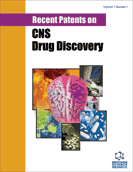Recent Patents on CNS Drug Discovery (Discontinued) - Current Issue
Volume 10, Issue 2, 2015
-
-
Peptide Agonists and Antagonists with Potential Application in Neurological Disorders
More LessAuthors: Anna Russo, Sara La Manna, Giancarlo Morelli, Ettore Novellino and Daniela MarascoBackground: Peptides are usually used to investigate regulatory networks and protein function. They can also be used in therapeutic research: They are employed both to identify and later to validate therapeutical target and in drug discovery processes. Their development enables the identification of several protein surfaces as crucial therapeutic targets and to promote the discovery of small drugs specific for these m Read More
-
-
-
Endocannabinoid System in Neurological Disorders
More LessAuthors: Roberta Ranieri, Chiara Laezza, Maurizio Bifulco, Daniela Marasco and Anna M. MalfitanoBackground: Several studies support the evidence that the endocannabinoid system and cannabimimetic drugs might have therapeutic potential in numerous pathologies. These pathologies range from neurological disorders, atherosclerosis, stroke, cancer to obesity/metabolic syndrome and others. Methods: In this paper we review the endocannabinoid system signaling and its alteration in neurodegenerative disorders like mu Read More
-
-
-
Immuno-Modulatory Properties of a Quinolin-2-(1H)-on-3-Carboxamide Derivative: Relevance in Multiple Sclerosis
More LessAuthors: Anna M. Malfitano, Chiara Laezza, Simona Pisanti, Clementina Manera and Maurizio BifulcoBackground: We have recently released the structure of a class of quinolin-2-(1H)-on-3-carboxamide derivatives and among them; the drug A2 has the highest CB2 receptor selectivity. Objective: In this work we assessed the immuno-modulatory properties of A2 in lymphocytes isolated from peripheral blood of multiple sclerosis patients and healthy donors. Methods: Cell proliferative response was measured by 3H-thymidine i Read More
-
-
-
Beyond the Direct Activation of Cannabinoid Receptors: New Strategies to Modulate the Endocannabinoid System in CNS-Related Diseases
More LessAuthors: Andrea Chicca, Chiara Arena and Clementina ManeraBackground: Anandamide (AEA) and 2-arachidonoyl glycerol (2-AG) are signalling lipids which belong to the class of endocannabinoids (ECs) and exert their actions by activating cannabinoid receptor type-1 (CB1) and type-2 (CB2). These receptors are involved in many physiological and pathological processes in the central nervous system (CNS) and in peripheral organs. Despite many potent and selective ligands for can Read More
-
-
-
Synthetic Cannabinoid Receptor Agonists and Antagonists: Implication in CNS Disorders
More LessAuthors: Clementina Manera, Chiara Arena and Andrea ChiccaBackground: Since the discovery of the cannabinoid receptors, numerous studies associate the endocannabinoid system with several physiological and pathological processes including cancer, appetite, fertility, memory, neuropathic and inflammatory pain, obesity, and neurodegenerative diseases. Over the last two decades, several researches have been dedicated extensively on the cannabinoid receptors ligands since th Read More
-
-
-
Phytocannabinoids and Cannabimimetic Drugs: Recent Patents in Central Nervous System Disorders
More LessAuthors: Roberta Ranieri, Daniela Marasco, Maurizio Bifulco and Anna M. MalfitanoBackground: Starting from the chemical structure of phytocannabinoids, isolated from Cannabis sativa plant, research groups designed numerous cannabimimetic drugs. These compounds according to their activities can be partial, full agonists and antagonists of cannabinoid receptors. Anecdotal reports and scientific studies described beneficial properties of cannabinoids and their derivatives in several pathological con Read More
-
-
-
Cannabinoids and Neuro-Inflammation: Regulation of Brain Immune Response
More LessAuthors: Roberta Ranieri, Chiara Laezza, Maurizio Bifulco, Daniela Marasco and Anna M. MalfitanoBackground: Cannabinoid receptors are involved in the neuro-pathogenic mechanisms of inflammatory conditions of the central nervous system and their expression can be modulated during diseases. Methods: In this manuscript we highlight the function of cannabinoid receptors, their signalling and expression at peripheral and central levels in order to understand their implication in neuro-inflammation and review the Read More
-
-
-
Neuropharmacological Properties of Withania somnifera - Indian Ginseng: An Overview on Experimental Evidence with Emphasis on Clinical Trials and Patents
More LessAuthors: Sarat C. Yenisetti, M. J. Manjunath and MuralidharaBackground: Owing to the increasing aged population globally, disorders and diseases of the CNS are anticipated to increase and profoundly impact the health care. As these neurodegenerative diseases (NDD) are complex, multifactorial and do not have identified etiological factors, unfortunately, drugs developed for the purpose have not met with the expected success. Hence, there has been a constant demand for Read More
-
Most Read This Month Most Read RSS feed
Article
content/journals/prn
Journal
10
5
false
en


